#James Physick
Text
Trailer Oficial: Barrio Boy
Esta película se desprende del cortometraje (C) que lleva el mismo nombre, el cual narra la vida de un peluquero latino que se enamora discretamente de un apuesto extraño durante el verano en un barrio más “machos” (risas) de Brooklyn.
Continue reading Trailer Oficial: Barrio Boy

View On WordPress
#Andrea Morales#Barrio Boy#Caitlin Mehner#Dennis García#James Physick#Keet Davis#Lou Liberatore#Manny Ureña#Pierre Jean Gonzalez#Scott Lindley#Teresa Yenque
0 notes
Text
Statues
Continuing my series of learning about things referenced in the book, I'm looking at things referenced in Alex & Henry's visit to the V&A Museum. These are all tagged #a series of learning about things that are referenced in the book, if you want to block the tag.
The main post for the V&A visit is here. This post is an image-heavy one, so i'll put a read more below the quote. Please note that some of the statues shown are nude.
-----
There’s a life-size sculpture of Zephyr, the Greek god of the west wind brought to life by Francavilla, a crown on his head and one foot on a cloud. Narcissus on his knees, mesmerized by his own reflection in the pool, […] carved by Cioli […] Pluto stealing Proserpina away to the underworld, and Jason with his golden fleece. They wind up back at the first statue, Samson Slaying a Philistine, the one that knocked the wind out of Alex when they walked in. He’s never seen anything like it—the smooth muscles, the indentations of flesh, the breathing, bleeding life of it, all carved by Giambologna out of marble. If he could touch it, he swears the skin would be warm.
-Chapter 10, Red White & Royal Blue
Zephyr

This statue was commissioned from sculptor Giambologna in 1574. One of thirteen destined for the garden at the Villa Bracci near Florence, Italy, they were brought to the UK in 1750, and rediscovered in the grounds of Kew Garden in 1852. The statue depicts Zephyr standing with his left leg slightly bent, his foot on a cloud, and he is wearing a crown. There is the upturned face of a cherub by his feet, whose cheeks are blown out and the wind becomes a billowing cloth, held by Zephyr. Zephyr is a character from Greek myths, known as the west wind of the springtime.
-----
Narcissus

This statue is thought to have been restored by Valerio Cioli around 1560, but originally dates back to Roman times. Originally identified as a lost Michelangelo statue of Cupid, it was later discovered this wasn't accurate. The statue depicts Narcissus as a youth returning from a hunt, and is thought that it may have been the centrepiece for a fountain. The myth of Narcissus holds that he saw his reflection in a pool of water and was mesmerised by his own beauty, and he dies unable to ever look away from himself.
-----
Pluto & Proserpine

This piece, a relief, shows four figures, some partially covered and others almost nude. The figures are three females and one male, who is representing Pluto. There is a smaller figure near the top, half contained within the background, depicting Cupid. A relief tends to be a sculpture which is attached in some form to its background. In this instance you can see that three of the figures are somewhat attached or within the back piece of the plaster. The relief was created in 1849, by British artist Edward James Physick.
In classical mythology, Proserpine (sometimes Proserpina) was the daughter of the goddess of agriculture, Ceres. Pluto, the god of the underworld, falls in love with Proserpine while she was collecting flowers with her companions and carries her to the underworld to make her his wife.
-----
Jason

This statue is thought to have been carved in the second half of the 1500s, but the sculptor is unknown. Art historians have various different ideas of who the artist might be. It depicts Jason, nude and holding the shaft of a spear in his right hand and the golden fleece in his left. Some of the sculpture is definitely not original, parts such as the front of the nose, two locks of hair over the forehead, and the penis all date to the 19th century. It is possible that the sculpture originated from the gardens of the Palazzo Strozzi, Florence, but can't be confirmed if it was there in the 16th century. However, that is where the statue was obtained from.
Jason is a well known Greek hero, who was first written about in the 200s BC by Apollonius of Rhodes, an Alexandrian poet. In the story, Jason leads the Argonauts to capture the Golden Fleece from the King of Colchis, where the King's daughter fell in love with Jason. She helped him to win the fleece with her magic skills, and both fled back to Greece to avoid the wrath of her father.
-----
Samson
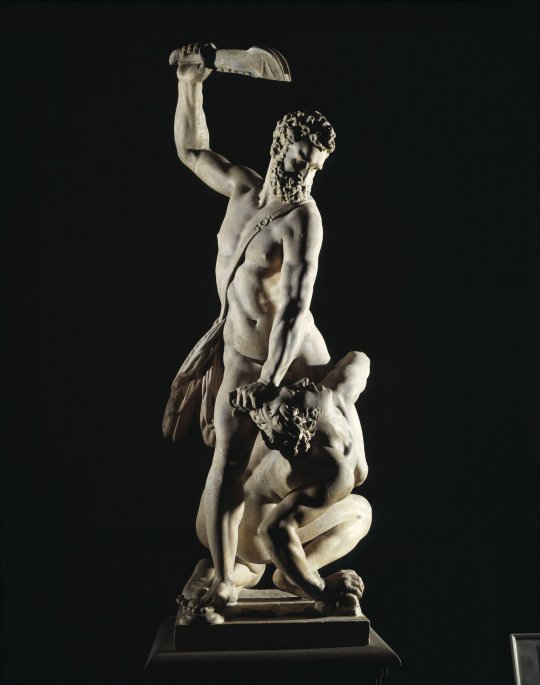
Samson was one of the last leaders who 'judged' Israel before the monarchy was established. Biblical accounts depict him as a Nazirite who had immense strength due to his long hair - if it were to be cut, he would lose his strength. This statue is based on Judges 15, where he 'strikes down a thousand men' with the jawbone of a donkey and becomes a leader of Israel.
This statue, sculpted by Giambologna in the early 1560s, and is one of very few to leave Italy. Inspired by an earlier unfinished project by Michelangelo, the work shows Samson posed diagonally with a Philistine crouching between his legs. The Philistine is holding a stone in his right hand, and Samson's left thigh in his left. Samson has his head pulled back and has his hand raised to strike the Philistine.
Art historians note that this is a good example of Giambologna's work with multiple viewpoints - rather than other statues in this post which are intended for you to view it from one angle, this one allows you to view it from different angles and see different features of his work.
-----
Sources:
V&A - Zephyr
Web Gallery of Art - Zephyr
V&A - Narcissus
V&A - Pluto & Proserpine
V&A - Jason
V&A - Samson Slaying a Philistine
Bible - Judges 15
#rwrb#red white and royal blue#rwrb movie#alt text added#elio's#elio's meta#a series of learning about things that are referenced in the book
9 notes
·
View notes
Text
'Does Quackery abound more in Law, Physic, or Divinity?'
London debating society topic for 19 December 1782, at the Coachmakers Hall (source)
For my own Part, I find it exceedingly difficult, even at this time, to determine in which of the Learned Professions I shall list myself.
John Laurens to James Laurens, 17 April 1772 (source)
John agonised for several months about his choice of studies, eventually giving up his notion of studying divinity - as this would "preclude me from bearing Arms in Defence of my Country" - and his "favourite Physick" (i.e., medicine) in order to pursue law instead.
What was clear is that he had no intention of joining the family business - "I never lov'd Merchandise, nor can I now".
12 notes
·
View notes
Text

Happy Halloween Everyone!!!
I had an amazing time playing Beth at the Emlen Physick Estate in “Phantoms of the Physick Estate: The Dearly Departed”!
I was able to get in some great jump scares at the end of the show!
Thank you Jacky, James, Ryan and Jen! I look forward to working with you again!
.
.
#thedearlydeparted #phantoms #phantomsofthephysick #emlenphysickestate #capemay #actor #acting #werewolf #halloween
0 notes
Text
Choice and select recipe’s, their names, compositions, preparations, vertues, uses and doses, as they are applicable to the whole practice of physick and chyrurgery....
Choice and select recipe’s, their names, compositions, preparations, vertues, uses and doses, as they are applicable to the whole practice of physick and chyrurgery….
538J
George Bate. (1608-1669)
Pharmacopoeia Bateana: or, Bate’s dispensatory. Translated from the second edition of the Latin copy, published by Mr. James Shipton. Containing his choice and select recipe’s, their names, compositions, preparations, vertues, uses and doses, as they are applicable to the whole practice of physick and chyrurgery: the Arcana Goddardiana, and their recipe’s…
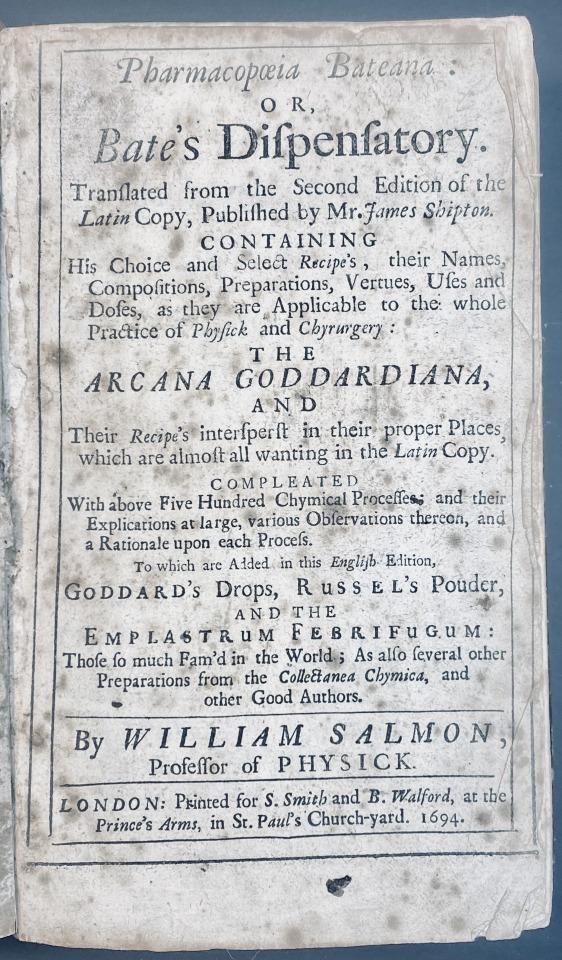
View On WordPress
0 notes
Photo


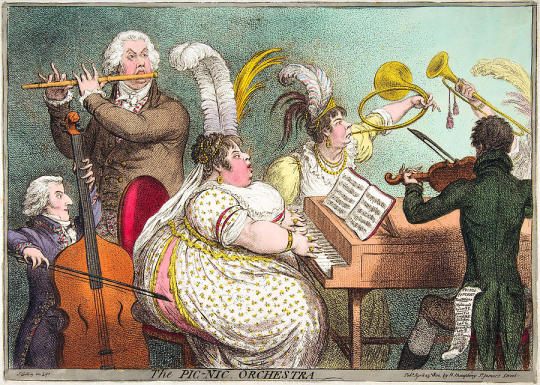
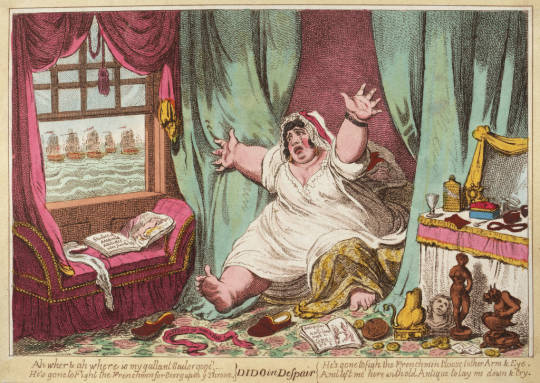
James Gillray, Taking physick – or – the news of shooting the King of Sweden!, 11 April, 1792, hand-coloured etching, 25.8 x 33.7 cm, National Portrait Gallery.
James Gillray, The Plumb-Pudding in Danger;–or–State Epicures Taking un Petit Souper, February 26, 1805, hand-colored etching, 26 x 36.2 cm, The Metropolitan Museum of Art.
“Napoleon Bonaparte, declared emperor of France in 1804, and the English statesman William Pitt sit across a dining table, each carving out a piece from a plum pudding in the shape of the world. The diminutive Napoleon, rising from his seat in order to reach the table, hungrily takes Europe while Pitt carves a large slice of ocean, illustrating the respective areas of power in the ongoing war between Britain and France.”
James Gilray, The Pic-Nic Orchestra, April 23, 1802, hand-colored etching and engraving, 25.4 x 35.6 cm, The Metropolitan Museum of Art.
James Gillray, Dido in Despair, February 6, 1801, hand-coloured etching, 25.3 x 35.8 cm, British Museum.
“The story of Dido and Aeneas had already been used by Gillray in Dido Forsaken (1787) to describe the way Mrs. Fitzherbert had been abandoned by The Prince of Wales during one of the crises brought about by the Prince's debts. Here Gillray uses it to caricature the despair of Lady Hamilton (Dido) as she looks out the window to see her lover Lord Nelson (Aeneas) departing with the Channel fleet to serve Britain in the Baltic.
Like Aeneas, Nelson had been seduced by the charms of a famously beautiful woman during an extended stay at her villa—in this case by Lady Hamilton whose aging husband was the British Minister at Naples. And in spite of the fact that both were married, neither Nelson nor Emma Hamilton made much effort to disguise their growing admiration for one another. When Sir William (thirty-five years his wife's senior) was recalled to England, he, Lady Hamilton and Nelson all traveled back to England together, taking a highly circuitous route home and exciting considerable scandalized remark along the way.
The timing of this print may have been prompted by the fact that the Hamiltons had arrived in England with the famous "'Hero of the Nile," as Nelson was popularly known, in November 1800 and had taken up residence in Picadilly as recently as January 6th. The trio were, as they say, "in the news." But the portrayal of Lady Hamilton as enormously fat may have had its source, apart from the caricaturist's love of incongruity and the lady's general proclivity towards plumpness, in the fact that she was nine months pregnant with twins. In fact, the only surviving child, a daughter significantly named Horatia, was born just a week before this print appeared (01/29/1801).”
0 notes
Photo
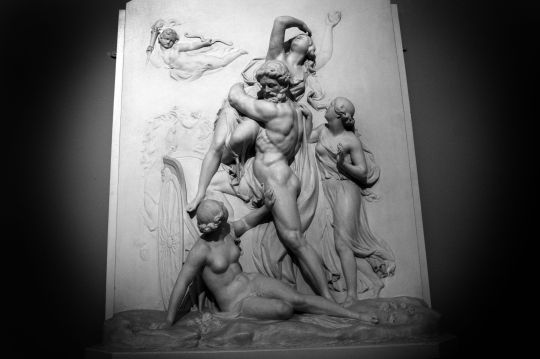
Pluto and Proserpine by Edward James Physick (1849)
#edward james physick#art#sculpture#statue#fine art#19th century#19th century art#academism#academicism#academic art#english artist#british artist#mythology#roman mythology#roman god#pluto#hades#proserpine#proserpina#classic art
381 notes
·
View notes
Photo

inktober (27)
doodles from Masque
#twilight stories#twilight fanart#Masque#i mean james physick was okay as carlisle and i was going to draw gn carlisle and esme in that dancing scene at the end#but then the actress who played esme--Sarah Akay--was BASICALLY gn esme in the flesh#and i love her and i wanted to draw her more#because honestly her 30s eyebrows were everything she IS esme#the ingenues of the silent movie era#Esme Anne Platt Evenson Cullen#Carlisle Cullen#ultimate otp#personal#inktober#she was ungodly beautiful in that dance scene#and she looked SO MUCH like elizabeth reaser in some scenes like :O??!?!#I really liked Esme's soft arms#she had the perfect Esme body type#wish I knew how to draw bodies tho.................
28 notes
·
View notes
Text

I posted 522 times in 2021
224 posts created (43%)
298 posts reblogged (57%)
For every post I created, I reblogged 1.3 posts.
I added 2.011 tags in 2021
#marquis de lafayette - 294 posts
#lafayette - 271 posts
#french history - 260 posts
#american history - 212 posts
#general lafayette - 204 posts
#american revolution - 180 posts
#history - 159 posts
#la fayette - 158 posts
#french revolution - 146 posts
#historical lafayette - 127 posts
Longest Tag: 64 characters
#honestly? what is so hard to understand about the whole concept?
My Top Posts in 2021
#5
Medicine in the 18th Century
For some time now I have been interested in 18th and early 19thcentury medicine. I have obtained a lot of “practical knowledge” from reading contemporary medical books. I complied some of these books into a little list, if there is anybody interested in reading them as well. There are books on surgery, on diseases and wounds in the army and in the navy, on natural and home remedies, on female health and so on and so forth.
Surgery:
A general system of surgery by Lorenz Heister (1743)
Modern improvements in the practice of surgery by Henry Manning (1780)
Specific diseases:
A new inquiry into the causes, symptoms, and cure, of putrid and inflammatory fevers by Sir William Fordyce (1777)
An essay on the diseases of the bile, more particularly its calculous concretions, called gall-stones by William White (1771)
Women’s health:
A treatise on female diseases: in which are also comprehended those most incident to pregnant and child-bed women by Henry Manning (1771)
Medical Correspondences:
Boerhaave's medical correspondence by Herman Boerhaave (1745)
Medical consultations on various diseases by Thomas Thompson (1773)
Domestic and natural medicine:
Domestic medicine: or, a treatise on the prevention and cure of diseases by regimen and simple medicines. by William Buchan (1791)
Primitive physick, or, An easy and natural method of curing most diseases by John Wesley (1770)
The compleat family physician by Hugh Smythson (1781)
Military:
Plain concise practical remarks, on the treatment of wounds and fractures by John Jones and Thomas Cadwalader (1776)
The diseases incident to armies: with the method of cure by Gerard Freiherr van Swieten and William Northcote (1776)
The Seaman's Medical Instructor by Nikolai Detlef Falck (1774)
106 notes • Posted 2021-05-08 09:46:21 GMT
#4
Yes, you can be interested in a historical person and researching their life without having any sexual fantasies with them or about them … in fact, that should be the norm and not the other way around.
115 notes • Posted 2021-07-24 20:45:38 GMT
#3
"While I was trying to rally them, the English honored me with a musket shot, which wounded me slightly in the leg. But the wound is nothing, dear heart; the ball hit neither bone nor nerve, and all I have to do for it to heal is to lie on my back for a while-which puts me in very bad humor. I hope, dear heart, that you will not worry; on the contrary, you should be even less worried than before, because I shall now be out of action for some time. (…) You must have received many letters from me, unless the English are as hostile to my letters as to my legs."
La Fayette in a letter to his wife Adrienne, September 12, 1777, right after he had been wounded in the Battle of Brandywine (September 11, 1777).
I can not but admire La Fayette’s sense of humour here!
130 notes • Posted 2021-08-16 18:31:14 GMT
#2
Resources
Historical research can be quite tricky at times – especially so if you are not a professionally trained historian, if you do not have access to libraries and achieves and the likes. Many great resources are behind paywalls and I therefor though I compile a list with resources (with links this time), mostly relating to the Marquis de La Fayette, that might come in handy and are easy and free to access.
Founders Online is a databank with letter from and by Benjamin Franklin, George Washington, John Adams (and family), Thomas Jefferson, James Madison, John Jay and Alexander Hamilton, including their respected correspondences with La Fayette. For starters, here are the correspondences between
La Fayette and George Washington,
La Fayette and Alexander Hamilton
La Fayette and Thomas Jefferson
La Fayette is sometimes listed under different names (or different spellings of his name) so keep that in mind.
The Papers of James Monroe is a project to catalogue the letter of, you have guessed it, James Monroe. Included in this project are also parts of the correspondences between Monroe and La Fayette.
Next up, there are a few online exhibitions and collections that I can recommend:
“La Fayette: Citizen of Two Worlds” by the Cornell University
“Lafayette and Slavery” by the Lafayette College (here is a second, slightly different version)
“The Prisoner of Olmütz” by the Lafayette College
“Marquis de Lafayette in Prints Collection” by the Lafayette College
Archive of the “Gazette of the American Friends of Lafayette” by the Lafayette College
“Marquis de Lafayette Collections” by the Lafayette College
“The Marquis de Lafayette Collection” by the Cleveland State University
The Library of Congress has a number of handwritten original letters that were exchanged between La Fayette and George Washington
The Internet Archive is a pure treasure chest of resources. They have collected a great deal of photos, videos, audio recordings, books and lose documents from libraries, collections and different archives. They also have a huge stock of curated websites. All of their resources are free, although some require a user account (which is free as well, but you have to sign up with your E-Mail Address). They have just so many great resources, from old texts to modern books - they truly have something for everyone. Here are a few links to contemporary books (memoirs and books by La Fayette and his family). All of that is just a very, very shallow peek into what the Internet Archives have to offer
Memoirs, Correspondences and Manuscripts of General Lafayette, Volume I, by the Marquis de Lafayette
Memoirs, Correspondences and Manuscripts of General Lafayette, Volume II, by the Marquis de Lafayette
Memoirs, Correspondences and Manuscripts of General Lafayette, Volume III, by the Marquis de Lafayette
(The Memoirs are also available in French and in the French version they are divided into eight (?) volumes.)
Life of Madame de Lafayette by Mme de Lasteyrie
Recollections of the Private Life of General Lafayette by M. Jules Cloquet
Lafayette in America, Volume I, by Auguste Levasseur
Lafayette in America Volume II, by Auguste Levasseur
All the books mentioned can also be obtained for free via Google Books.
To conclude this post, here are some non-La Fayette resources:
The Georgian Papers Program has digitalized a multitude of letters relating to Georg I, George II, George III, George IV and William IV, their families and governments. Most of the documents are not transcribed and so I will give you a fair warning; some of the handwritings will severely test your patience. The process of transcribing some of the papers is underway, you can join the project here.
Elephind lets you search more than 200 Million historic newspapers.
The Old Bailey Online lets you access all the court proceedings from the Old Bailey from 1674 up until 1913 and gives a great insight into English law and its evolution.
The Friedrich Schiller Archive is dedicated to the German poet Friedrich Schiller and has transcripts and analyses of all of his works as well as transcripts of the majority of his correspondences.
Here you can find all the issues of Jean-Paul Marat’s L’Ami du Peuple.
The National Archive in England, the National Archive and Records Administrations in America and the Archives Nationales in France offer a well of information (although they are sometime a bit troublesome to navigate).
Many museums, such as the Metropolitan Museum of Art or the Louvre have digitalized their collections and everybody can search items therein.
I am sure I have forgotten something but right know these are all the resources I can think of. I wish you all a happy researching!
145 notes • Posted 2021-09-09 17:30:51 GMT
#1
George IV and his Cello
George IV, as well as some other notable members of his family, played the cello. I play the cello myself so I just had to do some further research on that topic. He owned several cellos during his lifetime and was, by all accounts, a very good player but his gout and increased weight gain made it a bit problematic for him to actually play the cello in his later years. His fondness for this instrument though was generally known to the public and George’s cello was even featured in a political print published on October 11, 1820 by William Heath and titled “Nero fiddled when Rome was burning”.

George IV was supposed to be Nero and the British Empire was Rome. The title plays on the well-known story that well, the Emperor Nero allegedly played the fiddle while Rome burned down in July of 64 A.D. The print is packed with symbolism. Just to give a very superficial analysis; George IV sits in the foreground with his cello, the Lady beside him is Lady Conyngham, the gentleman being George IV playing the flute is Mister Bloomsfield and the other gentleman, the one whose dances with the bear, is Sir Neagle, George IV groom of the Bedchamber. The stereotypical English man, John Bull, is just entering through the door and reporting that Rome is on fire. Behind George IV there is a sheet detailing his expenses, the picture of a semi-naked lady and the portrait of a women with the head torn off are also visible in the background. Under the portrait, we can read the name “Caroline” and therefor know that the mishandled portrait refers to George IV wife, Caroline of Brunswick.
However, this satirical print is not all that we have. At least one of George IV cellos survived the turn of the centuries and can be safely attributed to him.
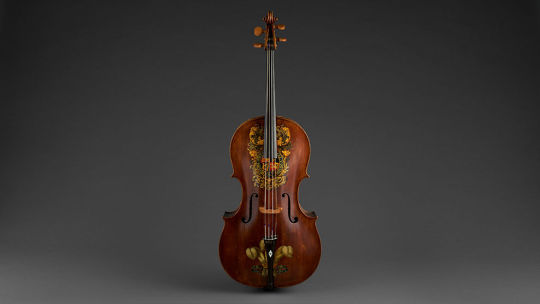

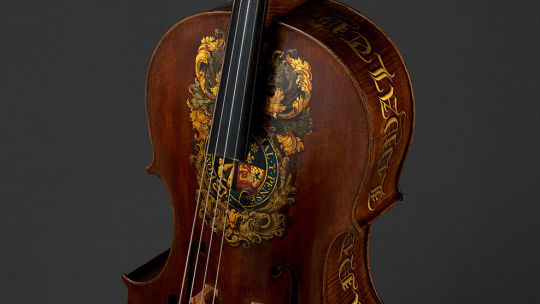


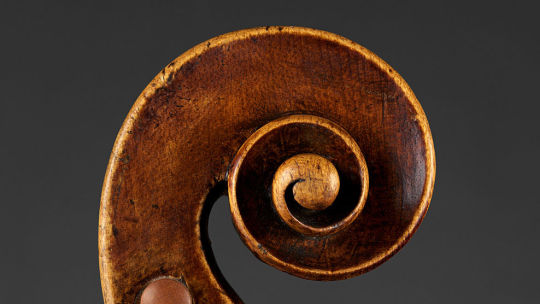
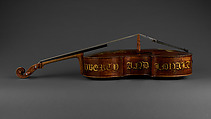
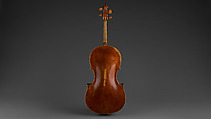
This absolutely magnificent piece of craftsmanship was either created in 1782 or during his time as Prince Regent between 1811 and 1820. Either way, it is simply stunning. It was crafted by a man named William Forster, a man whose family had long been making instruments. Forester had also crafted at least one violin for George’s younger brother Prince Ernest, the Duke of Cumberland. I cannot tell you enough how badly I want to play on this cello. If you look closely, you can see the marks of use. This cello, although still in excellent condition, has clearly been used. This is especially easy to spot on the back of the cello where the colour coat has been rubbed of where the instrument had been leaning against the players body. It seems as sadly the bow that accompanied the cello was lost sometime or had been destroyed.
In the third episode of the TV-series “Prince Regent” we can see George playing the cello for some guests. I would have love to see a reproduction of this particular instrument but alas the film team went for a much more subtle cello. (Fun fact as a sidenote: I may or may not have actually named my own cello George - is that strange?)
174 notes • Posted 2021-03-13 06:31:17 GMT
Get your Tumblr 2021 Year in Review →
11 notes
·
View notes
Text
Fall Reading Starts Tomorrow!
I enjoyed reading off of a themed list so much for Summer Reading that I decided to make one for fall, too. This one has spooky, scary, and creepy stories on it. Obviously. Some of them are really old, and some are newer. Most of them were pulled from various reading lists I've reblogged over the years.
So, in no particular order, here's my Fall Reading List:
The Woman in White - Wilkie Collins
The Physick Book of Deliverance Dane - Katherine Howe
The Moonstone - Wilkie Collins
Call of Cthulhu - HP Loevcraft
Carmilla - Joseph Sheridan Le Fanu
Practical Magic - Alice Hoffman
The Turn of the Screw - Henry James
Bright Smoke, Cold Fire - Rosamund Hodge
The Phantom of the Opera - Gaston Laroux
The Scarlet Gospels - Clive Barker
The Vampire: A Tale - John Polidari
House of Leaves - Mark Z. Danielewski
Confessions of an English Opium Eater - Thomas De Quincy
Enduring Love - Ian McEwan
The Cask of Amontillado - Edgar Allen Poe
And Then There Were None - Agatha Christie
The Tell-Tale Heart - Edgar Allan Poe
Ghost Stories of an Antiquary - MR James
The Strange Case of Dr Jekyll and Mr Hyde - Robert Louis Stevenson
Rebecca - Daphne de Maurier
The Castle of Otranto - Horace Walpole
Interview With a Vampire - Anne Rice
An Occurance at Owl Creek Bridge - Ambrose Bierce
Eileen - Ottessa Moshfegh
The King in Yellow - Robert W. Chambers
White is for Witching - Helen Oyeyemi
The Legend of Sleepy Hollow - Washington Irving
Zombie - Joyce Carol Oates
The Yellow Wallpaper - Charlotte Perkins Gillman
The Talented Mr. Ripley - Patricia Highsmith
Oedipus, King of Thebes - Sophocles
Young Goodman Brown - Nathanial Hawthorne
A lot of these are going to come from Project Gutenberg, but I own quite a few, too. Only a few are coming from the library.
I'm starting with Practical Magic - which I've never read - and I'm super excited. I love the movie and can't wait to read the book!
#fall reading list#unrestrained autumn fun#books#reading#reading list#fall vibes#autumn vibes#spooky stories#scary stories#creepy stories#horror stories
14 notes
·
View notes
Text
Somehow, although they are all different people, they each portrayed Carlisle and Esme perfectly.
Peter Facinelli as Carlisle & Elizabeth Reaser as Esme in The Twilight Saga Movies

James Physick as Carlisle & Sara Akay as Esme in The Twilight Storytellers Short: Masque

Conner Davis as Carlisle & Sara Maulucci as Esme, Cosplayers for the FTF Festival 2019

They all embodied the young vampire parents of the saga so beautifully.
#twilight#esme cullen#carlisle cullen#elizabeth reaser#peter facinelli#the twilight saga#twilight renaissance#forever twilight in forks#carlesme#carlisle & esme#carlisle x esme#esme cosplay#carlisle cosplay
308 notes
·
View notes
Text
Herbarium: Wormwood

Gender: Masculine
Planet: Mars
Element: Fire
Powers: Love, Protection, Psychic Powers, Spirit Communication
Magical Uses and History: Artemisia absinthium, commonly known as wormwood, derives its name from the goddess Artemis and from the word absinthum meaning "unenjoyable," referring to its bitter taste, as found in the old proverb, "As bitter as wormwood." The common name, wormwood, however, comes from its historic medicinal use of curing intestinal worms. Fun times!
During the 19th century, wormwood was used to flavor absinthe which is now banned due to its toxicity but is still used to flavor vermouth. However, absinthe, an alcoholic and highly-addictive drink, was commonly associated with love, and wormwood is still used in love potions today. Wormwood also appears in old love charms, as seen in the charm below:
"On St. Luke's Day, take marigold flowers, a spring of marjoram, thyme, and a little Wormwood; dry them before a fire, rub them to powder; then sift it through a fine piece of lawn, and simmer it over a slow fire, adding a small quantity of virgin honey, and vinegar. Anoint yourself with this when you go to bed, saying the following lines three times, and you will dream of your partner "that is to be.":
"St. Luke, St. Luke, be king to me,
In dreams let me my true-love see."
(Found in Folk-Lore of British Plants, Article VI, by James Mason in The Dublin University Magazine: A Literary and Political Journal, Volume 83 page 181)
In Russia, wormwood was commonly used to protect the wearer from Rusalki, water spirits who roamed forests and rivers with sharp claws and an hate for humans. Furthermore, Thomas Tusser, in 1577, wrote the following poem regarding wormwood's use in protecting against fleas and lice:
"While wormwood hath seed get a handful or twaine
To save against March, to make flea to refraine:
Where chamber is sweeped and wormwood is strowne,
What saver is better (if physick be true)
For places infected than wormwood and rue?
It is a comfort for hart and the braine,
And therefore, to have it, is not in vaine."
Today, it can be carried for protection against vengeful spirits, bewitchment, and harm in general, or hung from the rear-view mirror of your car to protect from accidents. Wormwood also has a strong association with snakes, as it is said that it was the first plant to grow from the path of the serpent as it exited the Garden of Eden. According to Culpepper, wormwood could be used to treat snakebites, as well as bee, wasp, and scorpion stings.
Wormwood is burned or worn to increase psychic powers or to summon spirits. According to Cunningham, it can be mixed with sandalwood and burned in a graveyard to summon the spirits of the dead. Wormwood is also used as an offering to spirits and can bind them to our realm if you know what you are doing.
Wormwood can be used in a number of spells including:
Divination
Love Spells
Spirit Work
Hedge Riding
Protection Magic
Medicinal Uses: One of wormwood's common names is green ginger, a name it was given as an allusion to its medicinal properties in common with ginger. Historically, wormwood has been used to treat a host of ailments, many of which have been vindicated through science. Its best use is as a bitter for digestive issues, including indigestion, gas, bloating, and worms, particularly roundworms and pinworms. It can also be used to reduce fevers and fight general infections, the same way ginger can be used.
Preparation and Dosage: Wormwood can be taken internally as an infusion or tincture. To make an infusion, pour 1 cup boiling water over 1-2 teaspoons of dried herb and leaves. Allow it to infuse for 10-15 minutes. Drink up to 3 times daily. For a tincture, take 1-4 milliliters of tincture up to three times a day. Externally, wormwood essential oil, if properly diluted, can be used as an insect repellant. Do not take wormwood oil internally. Wormwood is toxic, and should not be taken for more than 2 weeks at a time. Wormwood has been historically used to induce labor and as an abortion drug, so pregnant women who wish to remain pregnant or women attempting to become pregnant should not use wormwood. If you develop any of the following symptoms, reduce or discontinue use of the herb: nausea, vomiting, insomnia, excessive thirst, restlessness, vertigo, dizziness, trembling, numbness of the extremities, delirium, paralysis, convulsions, and/or seizures. As always, consult your doctor before using herbs.
Want to print a copy of this for your Book of Shadows? Click below for your free copy!
GET YOUR FREE COPY HERE!
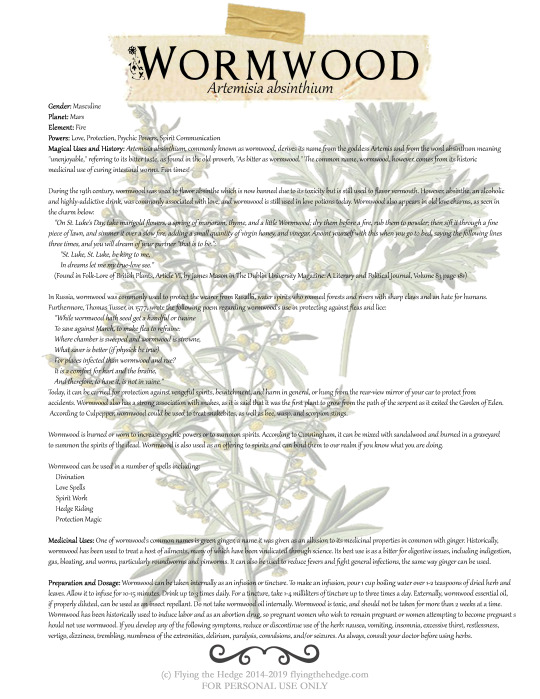
#herbarium#herb magic#herb magick#herbalism#wormwood#magical properties of wormwood#magick#magic#witch#witchcraft#hedge witch#hedgewitch#pagan#traditional withcraft#greenwitch#green with envy#green witchcraft#herbcraft#occult#spell#neopagan
340 notes
·
View notes
Photo
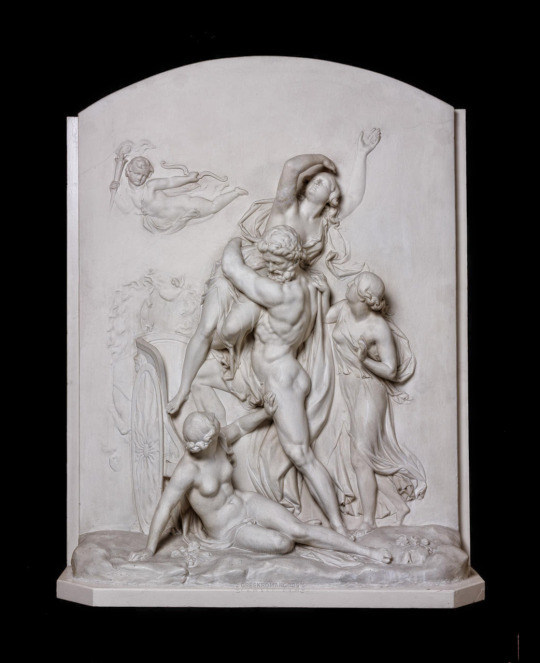
Pluto and Proserpine
1849
Edward James Physick (1829–1906)
Cast plaster
Victoria and Albert Museum
** Visit my Links page for my other blogs & Facebook Pages
177 notes
·
View notes
Text
Collyries: Cosmetics and Magical Gazing
This is a blog post about 'collyries', which I don't feel terribly bad about referring to as early modern magical cosmetics. I have frequent misgivings when Cool-Trying Historians attempt to excite interest in their topic by drawing clunky comparisons to some modern phenomenon ("hey fellow kids did you know books were, like, the iPads of medieval monastries?!") but, the thing is, these sorcerous 'confections' are fully designed to adorn the visage and literally empower and amplify the magic which comes out of faces. Gazing. Ensorcelling words. Enchanting breath. The evil eye. The look of love.
"Magical make-up" seems especially fair when we consider the mythic origins of cosmetics. In the Apocryphal Enochic materials, a particular fallen angel of the Grigori – the Watchers – is named as the explicit teacher of the violent and deceptive secrets of both weapons and cosmetics.
"And Azazel taught men to make swords and knives and shields and breastplates; and made known to them the metals [of the earth] and the art of working them; and bracelets and ornaments; and the use of antimony and the beautifying of the eyelids; and all kinds of costly stones and all colouring tinctures. And there arose much godlessness, and they committed fornication, and they were led astray and became corrupt in all their ways." [Book of Enoch 8:1–3a]
This tutelary patron, Azazel, is blamed fairly extensively by the Enochic God: ‘The whole earth has been corrupted through the works that were taught by Azazel: to him ascribe all sin.’ [Book of Enoch 2:8] Quite the reference for a curriculum vitae there.
So, 'collyries': a word describing magical preparations applied to the face, most typically the eyes. Thus, when Renaissance occult philosopher Heinrich Cornelius Agrippa warns of the power of sorcerous 'bindings', he offers some initial context for how these salves, pastes, and powders were considered:
'Now there are such kind of bindings as these made by Sorceries, Collyries, Unguents, love potions, by binding to, and hanging up of things, by rings, by charmes, by strong imaginations, and passions, by images, and characters, by inchantments, and imprecations, by lights, by sound, by numbers, by words, and names, invocations, sacrifices, by swearing, conjuring, consecrations, devotions, and by divers superstitions, and observations, and such like.'
Practically speaking, these collyries could come in the form of salves or washes. I am going to draw a line - however arbitrary - between the magic of beautifying or buffing oneself with compounds, and using these specialised magical preparations to imbue a 'magical expression' with greater potency. The former are employed to enchant oneself, whereas the latter I would argue enchant what one is throwing out, from evil side-eye to come hither glances. For instance, beyond this disclaimer, we will not consider the use of belladonna eye-drops - to widen the pupils and thus beautify the 'good lady' using them - despite these arguably being collyries, because they do not help with the "launching outwards" of a particular magical working, as much as they do glamour oneself. Likewise, the term 'collyrium' is sometimes used in medical herbalism to denote health-giving eye-washes and salves. I would also qualify these uses as internal 'buffs' like beautifying cosmetics. Now, this internal/external definitional divine falls apart in practice, I accept. If one is intending to stir the passions of lust in someone at a bar, we have two modes of looking: what we look like and how we look at them. For now though, if only for an artificial simplicity's sake (and brevity), I am going to concentrate on the latter. To reiterate for the herbalists: collyries can of course be employed to bolster health or affect one's physickal constituency, but for now we will content ourselves to consider those used to affect magical expression, especially gazing.
So how did such sorcerous eyeshadows and lipsticks work? In order to answer this we need to take a foray into understanding one of the underlying medical, occult, and cosmological models of the pre-modern magic: humoural theory.
But What Even Are A Humourals Theory
Humoural theory formed the central operative European medical model for (at least) one and a half millennia, surviving from ancient Greece well into the early modern period. It was simply one of the most historically embedded, best regarded and most widely used medical models in the early modern period. It charted typologies of personality and behavioural proclivities of emotional expression, and indeed emotional experience. As Nogah Arikha puts it, ‘humoural theory explained most things about a person’s character, psychology, medical history, tastes, appearance, and behaviour.’ [Nogah Arikha, Passions and Tempers: A History of the Humours (New York: Harper Collins, 2007), xvii] It is proper to consider humoural theory as a magical principle concerning the organisation of the organic naturally magical cosmos, for the humours were considered the biological corollaries of the four classical elements.
Humoural theory posited substances (literally, ‘moistures’) that ‘controlled the whole existence and behaviour of mankind, and, according to the manner in which they were combined, determined the character of the individual.’ [Raymond Klibansky, Erwin Panofsky, and Fritz Saxl, Saturn and Melancholy: Studies in the History of Natural Philosophy, Religion, and Art (Nendeln: Kraus reprint, 1979), p. 3] Moreover, they linked humans and their environment in that they ‘corresponded, it was held, to the cosmic elements and to the divisions of time’. [Klibansky, Panofsky, and Saxl, p. 3] These cosmic elements, these 'originall grounds of all corporeall things' are of course understood by an occult natural philosophy of what Agrippa calls 'elementated world'. [Heinrich Cornelius Agrippa, Three Books of Occult Philosophy (London, 1651), 8] These classical four elements were corresponded to the humours: choleric Fire, sanguine Air, phlegmatic Water, and melancholy Earth.
As a brief but important note, the sanguine humour was often called 'blood', but the term could be used to refer to the actual sanguine humour, to the gross carrier liquid of all humours (which is why phlebotomy was thought to void all deleterious humours not just the sanguine ones). Sanguinity could even on occasion refer to 'subtle' sanguine vapours or aerial spirits in the body. Crucially also 'seed' (both male and female) and breastmilk were considered forms of rarified blood. Semen, especially, ‘as Galen had explained, was concocted out of blood’’[ Arikha, p. 164-5. For more on seed and blood, see Lesel Dawson, Lovesickness and Gender in Early Modern English Literature (Oxford: Oxford University Press, 2008), p. 25-6, 85-6, 165-6, 209] This resulted in a further level of association ‘that those that are of a sanguine Complexion, are generally very Amorous’. [James Ferrand, Erotomania or A Treatise Discoursing of the Essence, Causes, Symptomes, Prognosticks, and Cure of Love or Erotique Melancholy (Oxford, 1640), p. 141] There is a rule-of-thumb that dictates that, in a way, prior to the wider acceptance and application of Paracelsian ideas about the organs, that all medical pathology was the study of malfunctioning or 'wounded' blood.
Humoural theory worked with connections between physiological and psychological affectivity in an incorporated and ensouled mind-body subject. It offered discourses for the distempers of the passions to be just as important to physical as to mental health. After all, at least potentially, ‘passions distemper the body, loose the spirits, ingender the humors, and produce diseases’ - moreover, ‘inordinate passion, is [itself] a most sharpe and violent disease: always dangerous and deadly…’ [M.I. Abernethy, A Christian and Heavenly Treatise: containing Physicke for the Soule (London, 1622), p. 264] This was no mere complaint about hysteria: 'the idea that heightened passion causes diseases and even death was common wisdom.’ [Michael MacDonald, Mystical Bedlam: Madness, Anxiety, and Healing in Seventeenth Century England (Cambridge: Cambridge University Press, 1981), p. 181.]
The elements and their humours were apprehended by occult philosophers and astrologers (when those even were distinct personages!) through the elemental 'Triplicities': the four elementally-based groupings of the twelve signs of the zodiac, as when we refer to Aries, Leo and Sagittarius as 'Fire signs'. This created a greater degree of specificity of the elements and humours as apprehended in time, as when the Sun passed through these as the belt of zodiac revolved over the course of a year. What was time after all, mused Proclus (and, crucially, quoted Agrippa), but the movement of the celestial bodies? The wandering stars of the seven classical planets were also afforded elemental and humoural identities and associations, adding to the nuance of astrological diagnosis of humoural imbalances, and indeed to the range of astrological magical interventions, to either down- or up-regulate the humours of oneself or others, to balance or imbalance.
Such planetary humouralism and humoural planetary magic survives fossilised in idiomatic and figurative language to this day: we speak of people as saturnine, or mercurial, or having a sunny disposition, or even of lunacy itself. Such humoural theory did not simply set stringent "personality types", it articulated proclivities to particular experience and expression of passions. As one seventeenth-century passion theorist phrased the relationship, 'Passions ingender Humors, and Humors breed Passions'. [Thomas Wright, The Passions of the Minde in Generall (London, 1601), p. 64.] Such was the passional-humoural feedback loop of expression and habituation: a hot-headed angry Martial person not only lived in an angry world, but made themselves more likely to become angrier more easily. As we shall see, by the porous or "leaky" early modern self, such a choleric feedback might even extend its influence through and beyond the body, breath and speech of the angry person to begin to innervate and galvanise the natural choler of 'elementated world' around them. The angry person makes their world angrier. A stray furious look here, a bitter word there. Ripples in the imaginal fields of affect and contagion.
Express Your Bad Self
The power of the humours - like other occult virtues - could be stirred, gathered, directed and deployed through words and signifying representational images, even images conjured and fixated in the imagination. This was most easily performed with humours and passions by being somewhat predicated on concepts of plethora (excess): from ‘the common Proverbe, ex adundantia cordis os loquitur, from the abundance of the heart, the tongue speaketh’. [Wright, Passions, p. 78-79] One could not help venting humours and passions when one expressed oneself. This welling tide of humours motivates us to speak up or pull a face at all. Indeed, the ex-pressive as well as behavioural affectivity of the passions was founded on the notion of the impassioned ensouled mind-body complex producing and being subject to inordinate unbalancing excesses. Impassioned and passionate, one simply had to get the words out.
Facial expressions, and especially the eyes, were some of the primary means to read and diagnose impassioned states. Yet this very readability also made them an excellent means of transferring passions. The seductive glance conveys a magical image as potentially powerful as any Venusian talisman of a maid holding a comb and mirror. Not only was this because ‘the countenance is the Image of the same’ passion prompting and enacted by it, but due to the origins of affections in the soul; for ‘by the eyes as by a window, you may looke euen into the secret corners of the Soule: so that it was well sayde of Alexander that the eyes are the mirror or Looking-glasse of the Soule.’ [Helkiah Crooke, Mikrocosmographia: A Description of the Body of Man Together with the Controversies Thereto Belonging (London, 1615), p. 8-9] The eyes did not merely convey meaning, but affectivity: the signifier was also the signified. An angry look carried an affective seed of anger itself. Thus a magnifying glass could also be a mirror, and this sense of reflection has a deep occult significance, as the ‘Looking-glasse’ looked both ways. As ‘the Eyes wonder at a thing, they loue it, they desire it; they are the bewrayers of loue, anger, rage, mercie, reuenge: in a worde; The eyes are fitted and composed to all the affections of the minde; expressing the very Image thereof in such a manner’. [Crooke, Mikrocosmographia, p. 9. Emphasis added.] Again, “expression” was a literal as well as figurative term. To think of expressions in both behavioural and idiomatic light, malefic choleric expressions and their dangerous martial qualities are preserved in much modern idiom: the sharp tongue, bitter words, cutting remarks, seeing red, staring daggers.
Gaze Amplifiers
A particular expression while gazing was not the only way to augment magically affective ‘overlooking’. The clearest example is that of ‘Collyries', magical salves to smear upon the eyes to magnify the effects of fascination. Here is Heinrich Agrippa on their potencies:
‘Collyries, and Unguents conveying the vertues of things Naturall, and Celestiall to our spirit, can multiply, transmute, transfigure and transform it accordingly, as also transpose those vertues which are in them into it, that so it cannot act only upon its own body, but also upon that which is neer it, and affect that by visible rayes charmes, and by touching it, with some like quality. For because our spirit is the subtile, pure lucid, airy, and unctuous vapour of the blood; it is therefore fit to make Collyries of the like vapours, which are more sutable to our spirit in substance, for then by reason of their likeness, they do the more stir up, attract, and transform the spirit. The like virtues have certain ointments and other confections.’ [Agrippa, Three Books of the Occult Philosophy, trans. 'JF' (London, 1651), p. 90]
Such 'Collyries' would be made from ‘the gall of a man’, which was the main depository of yellow bile, and thus powerful for strengthening choleric gazes. Consider the very phrase "having the gall": filling with fiery boldness. Such collyries could also be compounded from animal ingredients, such as ‘the blood of a lapwing, of a bat, and of a goat’. [Agrippa, Three Books, p. 134] These animal components were considered sources of appropriate occult virtue. One reason for this consideration was the idea that humours and passions were regulated by the rational faculties of the human soul, faculties that animals lacked. So the beasts of the earth were considered to express and even, in their use as spell components, enmatter unadulterated humours and passions. Raw feelings, to be marshalled and manipulated. Wolf parts were choleric, as their howling indicated. Cats were melancholy... as their howling also indicated. For more on this fascinating dimension to Shakespearean witches' brews, see Gail Kern Paster's 'Melancholy Cats, Lugged Bears, and Early Modern Cosmology: Reading Shakespeare's Psychological Materialism Across the Species Barrier', in Reading the Early Modern Emotions, edited by Paster, Katherine Rowe, and Mary Floyd-Wilson.
Now, I hope I do not need to state the importance of knowing the chemical and biological as well as magical affectivity of any materials you might chose to use in this manner. I do not wish to speak down to anyone by stating "do not rub random blood into your peepers". But, yknow, maybe don't. There are a wealth of herbs and other ingredients that contain the appropriate occult virtues to work as collyries that won't cause other problems. Consider adapting planetary correspondences for plant allies you already work: choleric humours respond to Solar and Martial virtues; phlegmatic humours to those of Venus and the Moon; jovial Jupiter is considered especially sanguine; and Saturn is well known as the ruler of melancholy. Again, to disclaim, I must strongly advice that if you are pregnant or might be pregnant, do not attempt any working, magical or medicinal, where you are taking herbs or other substances internally or through a mucous membrane like the eyes.
By these means of compounding humourally and passionally-charged materia, the humours expelled through the eyes and the passions expressed, vivified, and received were empowered and amplified by the virtues of these salves and eye-washes: for ‘such like passions also can magical confections induce, by suffumigations, by collyries, by unguents, by potions, by poisons, by lamps and lights, by looking-glasses, by images, enchantments, charms, sounds and music’. [Agrippa, Three Books, p. 135] Such magical eye-washes were not some half-baked tacked-on gimmick; they were as core a part of magical tool use as lamps, images, and incantations.
Yet amplifying the ejection of a sort of astral poison out of one's eyes was not the only use of such preparations. Agrippa goes onto to foreground the importance of sight and vision in terms of the all-too-real magic of the imagination:
'Now the sight, because it perceives more purely and clearly than the other senses, and fastening in us the marks of things more acutely and deeply, doth most of all and before others, agree with the phantastic spirit, as is apparent in dreams, when things seen do more often present themselves to us than things heard, or any thing coming under the other senses. Therefore, when collyries or eye-waters transform visual spirits, that spirit doth easily affect the imagination, which indeed being affected with divers species and forms, transmits the same by the spirit unto the outward sense of sight; by which occasion there is caused in it a perception of such species and forms in that manner, as if it were moved by external objects, that there seem to be seen terrible images and spirits and such like. So there are made collyries, making us forthwith to see the images of spirits in the air or elsewhere...' [Agrippa, Three Books, p. 134]
There is also a strong dimension by which collyries affected the imagination. For ‘when collyries transform visual spirits, that spirit doth easily affect the imagination’ either of oneself – in order to ‘make invocated spirits to be seen’ – or of others, in order to manipulate their senses and passions. (Those interested in magical preparations for seeing spirits might find this blog post compiling grimoiric instructions for such material useful.) These perceptual distortions of the magical gaze upon the overlooked’s imaginations could induce targets to ‘hear horrid, or delectable sounds’ making them ‘angry, and contend, nobody being present, and fear where there is no fear’. [Agrippa, Three Books, p. 134-5] Here occult passion manipulation is working directly on the imagination, through the inducement of impassioned hallucinatory states.
Lest this talk of imagination sound "too psychologising", we should bear in mind Agrippa is also clear that 'by divers rites, observations, ceremonies, religions and superstitions; all which shall be handled in their places. And not only by these kind of arts are passions, apparitions and images induced, but also things themselves, which are really changed and transfigured into divers forms...' The field-like qualities of the pre-modern magical imagination did not mean "it's all in your head". Rather, that something moving through your head (and heart!) - the tides of choleric boldness and anger, phlegmatic fear and hope, sanguine love and lust, and melancholy cogitation - flowed through us, into and out of the world, reminding and reanimating 'elementated' components of the responsive interconnected cosmos of their own natural magic. Nature itself could also be charmed, in this continually unfolding dance of attraction and rebuffing; the inhale and exhale of sympathia and antipathy expressing itself through the actions of a dancefloor or cast shade, variously as majestic and cutting as the turning celestial orbs spinning to the music of the spheres.
103 notes
·
View notes
Quote
My present Prospect," John told Uncle James, "is either to be lodged in the Temple, or in some reputable Family, under the Eye of an honest Lawyer if such a one can be found, and to study the Laws of my country very digilently for three years." Yet he possessed strong misgivings about his chosen profession that he revealed frankly: 'And a horrible prospect it is, that I am to get my Bread by the Quarrels and Disputes of others, so that I cant pray for success in my occupation without praying at the same time that a great Part of Mankind may be in Error either thro' Ignorance or Design, the only noble Part of my Profession is utterly unprofitable in this world, I mean the Defence of the weak and oppress'd; it is a part however that I am determined never to neglect, for altho' it enriches not, it must make a Man happy, what can be equal to the Heart felt Satisfaction which abounds in him who pleads the Cause of the Fatherless and the Widow, and sees right done to him that suffers wrong. Thus after long wavering I am now fix'd, no more Talk to me either of Physick, or Commerce, Law is the knotty Study which I must endeavour to render pleasant."
John Laurens and the American Revolution
Wonder how that went down with Alexander. Also I agree that people shouldn’t just make a living off other people’s misfortunes and arguing for the sake of it and not for the sake of justice. It’s a very corrupt system and the arguments against it put forth in this letter are still compelling today.
13 notes
·
View notes
Text
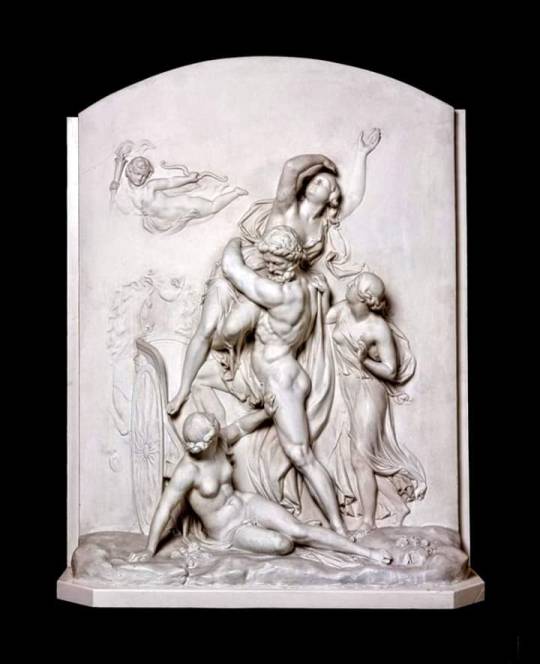
«[…]la nuova Artemide fu dichiarata sorella di Apollo, figlia di Leto.
Questa concessione lasciò scontenti beoti e ateniesi: infatti presso di loro la Dea Vergine era venerata con il nome di Atena, e aveva un'importanza tale nel loro culto che si dovette creare per lei un altro posto sull'Olimpo. Dopo molte altre discussioni fu ammessa come Atena, ma solo a condizione che anche lei accettasse una nuova origine: si disse che non era figlia della Dea Madre e si sostenne che era saltata fuori, già armata di tutto punto, dalla testa di Zeus. Questo serviva a dimostrare che il Padre Zeus poteva generare figli, anche femmine, senza ricorrere al ventre di una donna, soltanto con un atto autonomo di volontà.
Atena si pentì del suo tentativo di detronizzare Zeus e divenne la più ubbidiente e operosa delle figlie e la più zelante custode della giustizia.
Quando fu sollevata la questione dell'Oltretomba, i fedeli della Triplice Madre fecero un tentativo di attribuirlo alla Dea, nella veste di Ecate, come suo antico e inalienabile dominio; ma le loro pretese furono respinte dai seguaci di Zeus, che temevano che la Dea potesse usare il regno sotterraneo come base per muovere guerra all'Olimpo. Lo assegnarono allora al cupo Ade, fratello di Zeus. Comunque, poiché era impossibile tenere la Dea completamente fuori dall'Oltretomba, ella vi fu ammessa come Persefone, ma sottoposta a una stretta tutela da parte dello zio Ade, e con poco potere nel governo del suo antico dominio. La Madre Ecate fu trattata in modo ancor più vergognoso: poiché le erano offerti, secondo l'usanza, sacrifici di cani, ella divenne un cane a tre teste in un canile alle porte dell'Ade, con il nome di Cerbero.» (Robert Graves, Il vello d’oro, 1944)
IMG: Edward James Physick, Pluto and Proserpine [Plutone e Proserpina] (1849 ) - Victoria and Albert Museum, Londra
0 notes